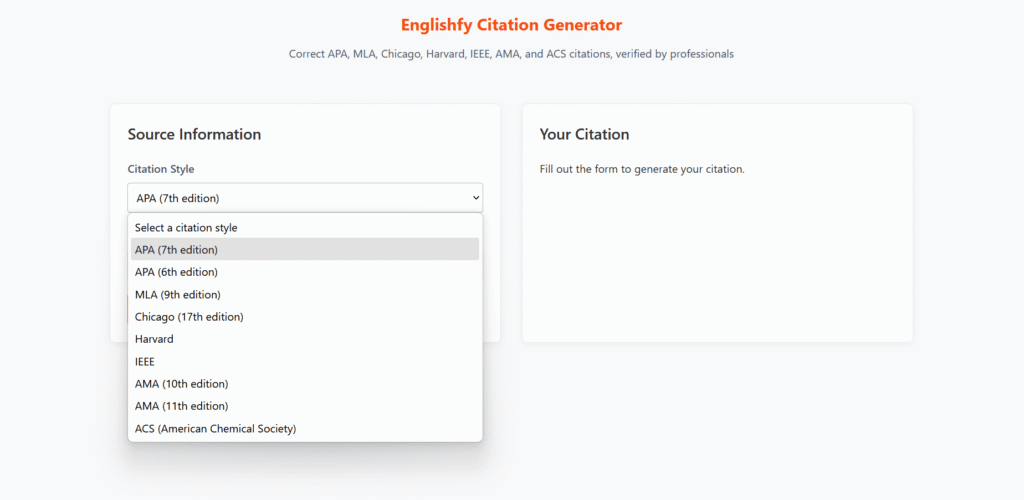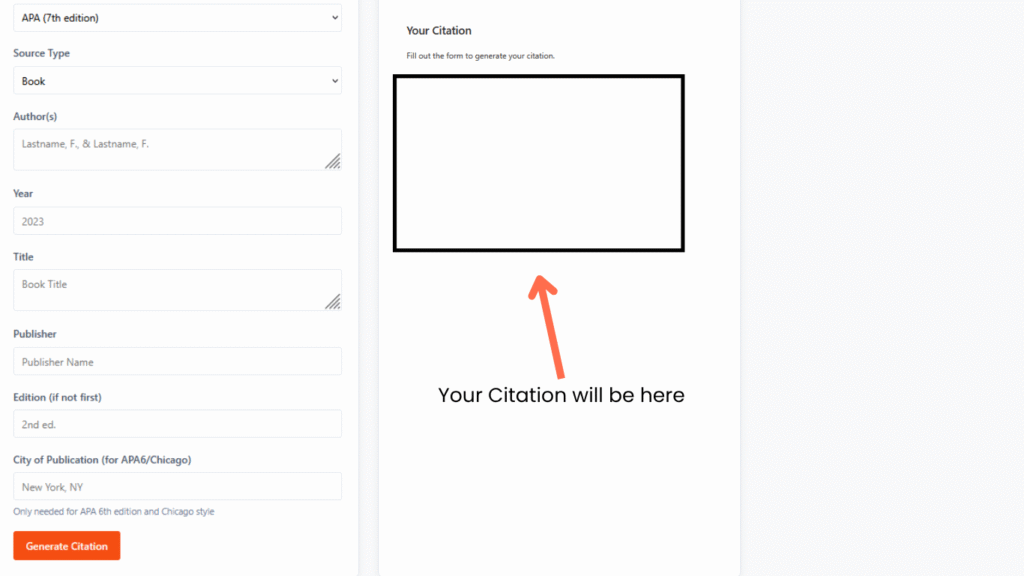APA (American Psychological Association) style is one of the most commonly used citation styles for academic writing, especially in the social sciences, psychology, and education. The 7th edition is the latest version, providing clear guidelines on how to properly cite sources and format your paper.
In this guide, you’ll learn how to cite in-text, create a reference list, and format common sources using APA 7th Edition.
Steps by Step Guide to Cite in APA 7th Edition
Just follow the steps to fill the citation form and get your citation.
In first step, choose citation style APA (7th edition) from the drop-down menu.

In second step, you have several options of source type. Choose one of the six source types you want to create citation with from book, journal article, website, newspaper article, video or other type.

In third step, after choosing “Book” as source type (choose your own choice), fill author name, year, publisher name, edition, and city of publication, then press “Generate Citation” button. Your citation will be in the box.

If you want to create citation on “Cite in APA 7th Edition” just visit citation page and start generating.
Why Proper Citation Matters
Proper citation is essential for:
- Avoiding plagiarism by crediting original authors.
- Showing readers where your information comes from.
- Maintaining academic integrity and trustworthiness.
Basic Principles of APA 7th Edition
The APA 7th Edition made a few updates from the 6th Edition, such as using “et al.” for three or more authors in in-text citations and providing more inclusive language guidelines. Below are the key basics you should know.
1. In-Text Citations
In-text citations briefly identify the source and guide the reader to the full reference at the end of your work.
Parenthetical vs. Narrative Citations
APA allows two types of in-text citations:
- Parenthetical citation: (Author, Year)
- Narrative citation: Author (Year)
Examples
- Parenthetical: (Smith, 2020)
- Narrative: Smith (2020) argues that…
2. Reference List
Every source cited in-text must appear in the reference list at the end of your paper. The reference list should:
- Be alphabetized by the surname of the first author.
- Use a hanging indent (the first line flush left, subsequent lines indented).
- Include full publication details.
Common APA 7th Citation Formats
Here is a table with examples for the most common source types in APA 7th Edition:
| Source Type | Reference List Format | Example |
|---|---|---|
| Book | Author, A. A. (Year). Title of the book. Publisher. | Brown, D. (2017). Origin. Doubleday. |
| Journal Article | Author, A. A., & Author, B. B. (Year). Title of article. Journal Name, volume(issue), pages. https://doi.org/xxxx | Clark, P., & Green, L. (2018). Learning styles in modern education. Journal of Learning, 12(3), 45–59. https://doi.org/10.1234/jl.2018.003 |
| Website | Author, A. A. (Year, Month Day). Title of page. Site Name. URL | Adams, M. (2022, June 15). How to cite a website. EasyCite. https://www.easycite.com/how-to-cite-a-website |
Formatting Tips for APA 7th Edition
- Font: Use a readable font such as 12-pt Times New Roman, 11-pt Calibri, or 11-pt Arial.
- Spacing: Double-space the entire paper, including the reference list.
- Margins: Use 1-inch margins on all sides.
- Title Page: Include a title page with the paper’s title, your name, and institutional affiliation.
Special Cases
Multiple Authors
When citing multiple authors, APA 7th has simplified the rule:
- Two authors: Cite both names every time. (Smith & Jones, 2021)
- Three or more authors: Cite the first author and “et al.” (Clark et al., 2019)
No Author
If a work has no author, use the title in the in-text citation and move it to the author position in the reference list.
- In-text: (“APA Guide,” 2020)
- Reference: APA Guide. (2020). Title of the work. Publisher.
Best Practices for Avoiding Citation Errors
To avoid mistakes while citing in APA 7th:
- Always double-check author names and publication years.
- Be consistent with punctuation and italics.
- Use DOIs for journal articles when available.
- Review your reference list for any missing sources cited in-text.
Conclusion
Mastering APA 7th Edition citations doesn’t have to be stressful. By following the guidelines for in-text citations and reference lists, and by practicing with different source types, you’ll quickly build confidence. Always consult the official APA Publication Manual or trusted online resources if you’re unsure.
Proper citation not only improves your academic work but also respects the intellectual property of other writers and researchers.
FAQs about APA 7th Edition
What does an in-text citation look like in APA 7th edition?
In APA 7th edition, an in-text citation usually includes the author’s last name and the year of publication. For example: (Smith, 2020). If you use a direct quote, you should also add the page number: (Smith, 2020, p. 15).
Do I need to include a reference list with APA citations?
Yes! In APA style, every in-text citation must have a full reference in the reference list at the end of your paper. This list gives all the details about your sources so readers can find them easily.
How do I cite a website in APA 7th edition?
To cite a website in APA 7th edition, include the author, year, title of the page, and the URL.
What if there is no author for my source?
If there’s no author, start with the title instead. In the in-text citation, use a shortened version of the title and the year: (“How to Write,” 2023).
What is the difference between a reference list and a bibliography in APA?
In APA style, you use a reference list, not a bibliography. A reference list only includes the sources you actually cited in your paper. A bibliography can include extra reading material, but APA 7th edition does not require it.
